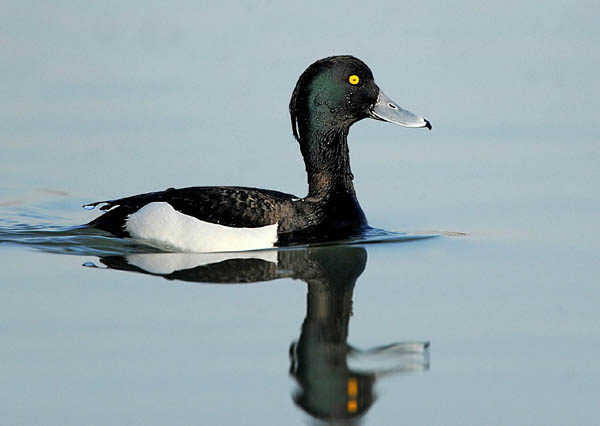Aythya fuligula
IUCN
LCBasic Information
Scientific classification
- name:Aythya fuligula
- Scientific Name:Marsh duck, crested duck, black-headed duck,Aythya fuligula,Tufted Duck
- Outline:Waterfowl
- Family:Anseriformes Anatidae Duckling
Vital signs
- length:40-47cm
- Weight:550-900g
- lifetime:15years
Feature
A deep-water bird with a crest on its head, good at diving with its wings folded
Distribution and Habitat
In China, it breeds in the far northeast. During migration, it passes through the area north of the Yangtze River and winters in the Yangtze River and its southern basin, including Taiwan Island and Hainan Island. Abroad, it breeds in the northern part of Eurasia and winters in the southern part of Eurasia, North Africa, the Korean Peninsula, southern Japan, and the northern Philippines.
It mainly inhabits open water surfaces such as lakes, rivers, reservoirs, ponds, swamps, and estuaries. In the breeding season, it mostly chooses open lakes and rivers with rich shore plants. In the non-breeding season, it mostly inhabits freshwater waters such as deep lakes, rivers, swamps, and ponds rich in aquatic plants. It has strong diving ability and often gathers in groups of hundreds, mixed with other diving ducks.
Appearance
The male has black upper body, purple head with long crest, white wings, flanks and lower abdomen. The female has brown body, dull head, long crest but shorter than the male, lighter lower abdomen, flanks sometimes stained white, white spots at the base of the beak from inconspicuous to particularly obvious. The iris is golden yellow, the beak is lead gray with a black tip, and the feet are lead gray.
Details
The Crested Pochard is a migratory bird. Every year in late March and early April, it migrates from its wintering grounds in the south to North China and southern Northeast China, and arrives at Changbai Mountain in the eastern part of Northeast China and Heilongjiang Province in the northern part of Northeast China in mid-April. In autumn, it begins to migrate southward in late September and early October; it arrives at its wintering grounds in the south from late October to early November. It often migrates in large groups.

It likes to live in groups. It often moves in groups, especially during migration and wintering, when it often forms large groups of hundreds of birds. It is good at swimming and diving, and can dive 2-3 meters underwater. When swimming, its tail hangs down to the water surface. They often float in groups in the rippling lake, and rarely move in shallow water near the shore or on the turbid water surface. When taking off, they flap their wings rapidly against the water, and run a distance on the water before they can fly, which makes them clumsy and inflexible, but after they fly, they fly very fast and powerfully.
Calls: There are often few calls in winter. When flying, it makes a hoarse, low-pitched kur-r-r, kur-r-r call.

Crested Pochard mates in late winter or early spring, with no set rules. Some birds form pairs before migrating, while others seek mates only after arriving at the breeding grounds. In all cases, they mate in noisy tufted migratory groups, most of which reach sexual maturity in the first winter, but most females do not participate in reproduction until the second year of age. Pair bonding usually begins in late winter and continues until the spring of the second year on the migration route. Some populations also form pairs after arriving at the breeding grounds. Nests are built in the grass or bushes by the lake or on the island in the middle of the lake, usually not far from the water. The nest is well hidden. Usually a natural pit is used or a pit is dug, and then padded with dead grass stems and grass leaves, with a lot of down feathers inside. The breeding period is from May to July. Each nest lays 6-13 eggs, usually 8-10 eggs. The eggs are gray-green or dirty olive in color, with a size of 53-66×38-77 mm, an average of 59×71 mm, and a weight of 52-61 grams, an average of 56 grams. The female bird incubates the eggs. The incubation period is 23-25 days. The chicks are female. After hatching, the chicks can follow the parents and forage. After more than 40-50 days of the chick period, they can fly.








